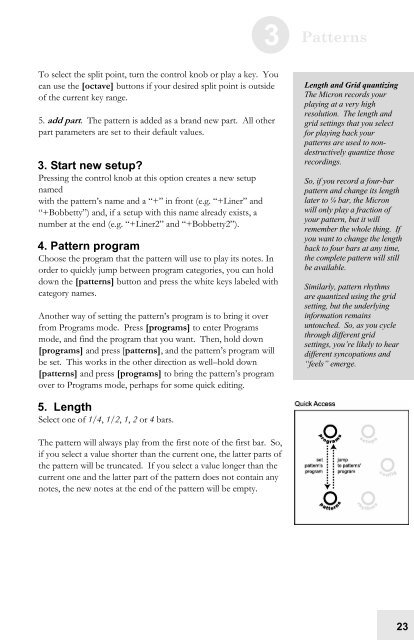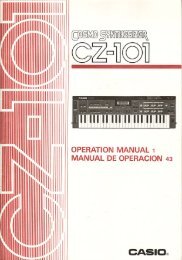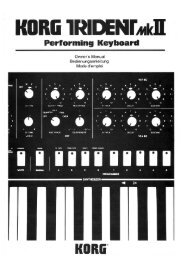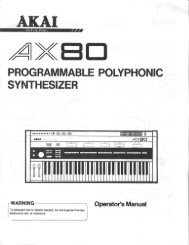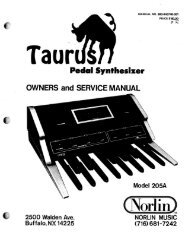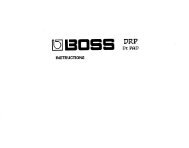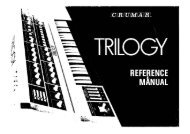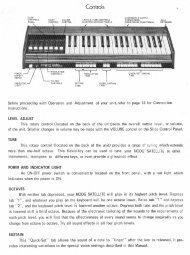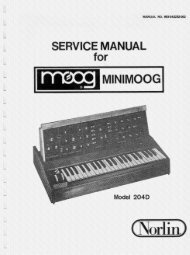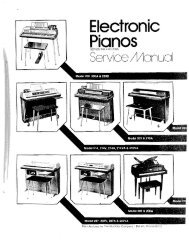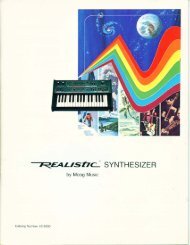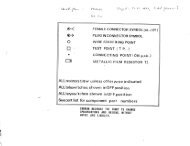Alesis Micron Owners Manual.pdf - Fdiskc
Alesis Micron Owners Manual.pdf - Fdiskc
Alesis Micron Owners Manual.pdf - Fdiskc
Create successful ePaper yourself
Turn your PDF publications into a flip-book with our unique Google optimized e-Paper software.
To select the split point, turn the control knob or play a key. You<br />
can use the [octave] buttons if your desired split point is outside<br />
of the current key range.<br />
5. add part. The pattern is added as a brand new part. All other<br />
part parameters are set to their default values.<br />
3. Start new setup?<br />
Pressing the control knob at this option creates a new setup<br />
named<br />
with the pattern’s name and a “+” in front (e.g. “+Liner” and<br />
“+Bobbetty”) and, if a setup with this name already exists, a<br />
number at the end (e.g. “+Liner2” and “+Bobbetty2”).<br />
4. Pattern program<br />
Choose the program that the pattern will use to play its notes. In<br />
order to quickly jump between program categories, you can hold<br />
down the [patterns] button and press the white keys labeled with<br />
category names.<br />
Another way of setting the pattern’s program is to bring it over<br />
from Programs mode. Press [programs] to enter Programs<br />
mode, and find the program that you want. Then, hold down<br />
[programs] and press [patterns], and the pattern’s program will<br />
be set. This works in the other direction as well–hold down<br />
[patterns] and press [programs] to bring the pattern’s program<br />
over to Programs mode, perhaps for some quick editing.<br />
5. Length<br />
Select one of 1/4, 1/2, 1, 2 or 4 bars.<br />
The pattern will always play from the first note of the first bar. So,<br />
if you select a value shorter than the current one, the latter parts of<br />
the pattern will be truncated. If you select a value longer than the<br />
current one and the latter part of the pattern does not contain any<br />
notes, the new notes at the end of the pattern will be empty.<br />
3 Patterns<br />
Length and Grid quantizing<br />
The <strong>Micron</strong> records your<br />
playing at a very high<br />
resolution. The length and<br />
grid settings that you select<br />
for playing back your<br />
patterns are used to nondestructively<br />
quantize those<br />
recordings.<br />
So, if you record a four-bar<br />
pattern and change its length<br />
later to ¼ bar, the <strong>Micron</strong><br />
will only play a fraction of<br />
your pattern, but it will<br />
remember the whole thing. If<br />
you want to change the length<br />
back to four bars at any time,<br />
the complete pattern will still<br />
be available.<br />
Similarly, pattern rhythms<br />
are quantized using the grid<br />
setting, but the underlying<br />
information remains<br />
untouched. So, as you cycle<br />
through different grid<br />
settings, you’re likely to hear<br />
different syncopations and<br />
“feels” emerge.<br />
23


